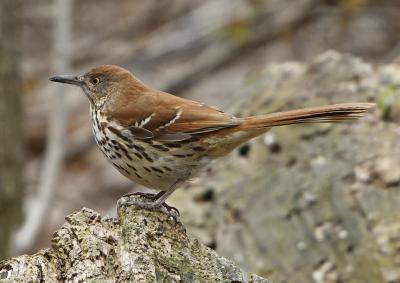Bird of the Month April 2025: Brown Thrasher
Avian rustler
You're walking down a trail through the woods and you hear rustling just off the path. Chipmunk? Squirrel? Maybe. It could also be a Brown Thrasher, a ground foraging bird that is migrating into our area right now.
Brown Thrashers are at the forefront of forest bird migration here, that exciting time when birds are heading north for nesting. Lucky for us, this charming bird will stay in our region to breed.
Brown Thrashers are indeed brown. The top of their heads, back, and long tail are a reddish brown that is often referred to as rufous by birders. Their undersides are white, adorned with dark vertical streaks. Their look is completed with two thin white lines on each wing (called wing bars), yellow eyes, and a long, slightly curved bill. Both males and females have the same coloration.
They get the "thrasher" in their name from their unique feeding behavior — a rapid side-to-side motion, sweeping leaf litter and top soil layer for insects, fallen seeds, and berries. Their primary food in the breeding season is insects and other arthropods, but they turn to fruit and berries in late summer and fall.
Because thrashers spend a considerable amount of time in dense brush, they can be difficult to spot, but don't worry, their loud, emphatic voices often give away their presence. Thrashers sing a rich, bubbly song that is repeated two or three times with pauses in between each phrase.
They are one of three representatives of the Mimidae family found in our area. The Mimidae, or "mimic thrushes" are famous for copying phrases of songs from other species and incorporating them into their own repertoire. They are joined in this group by Gray Catbirds and Northern Mockingbirds.
Their delightful vocals are performed to impress potential mates and advertise their territories. When they do pair up, they nest low in a tree or shrub, or sometimes even on the ground. Both male and female birds incubate a clutch of three to five eggs and feed their young once they hatch.
They are relatively common in our region during the summer but their population is on the decline overall. Look for them at the edges of fields or near large clusters of shrubs and trees. Many can be found at Presque Isle or woods near you. Just listen for that rustle and its bouncy song.
Mary Birdsong is the lead shorebird monitor for Erie Bird Observatory. Learn more at eriebirdobservatory.org or on their social media channels. She can be reached at mbirdsong@eriereader.com


.png)
